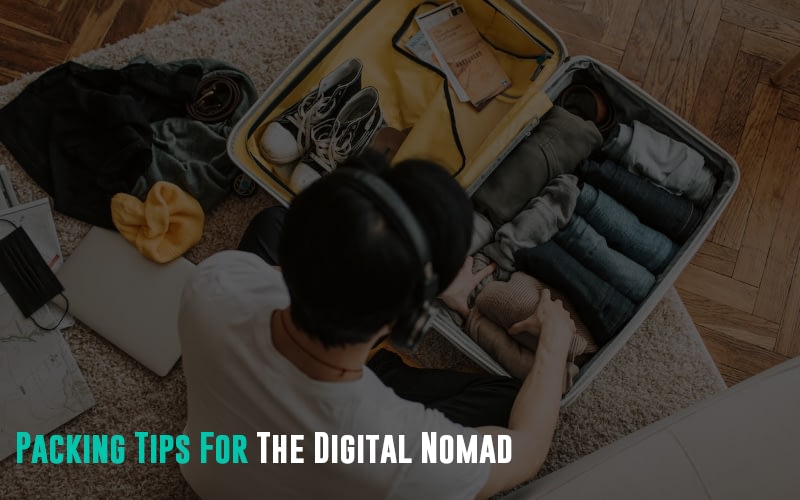Packing is an art form that takes experience and thought to perfect. You will know you have hit the perfect balance mark if you travel without extra hassles and mishaps. Leaving home with a limited supply of what you take can make or break your travel experience. I tend to work everywhere I travel, so I am locked to specific gear no matter how adventurous my travels may be. Let’s explore some packing tips for the digital nomad.
Featured Image Credit
Weight Considerations
First thing first! It would be best to have a good idea of where you will travel to or through. Be it smaller aircraft, airline policy, or country policy weight limits. These could drive a clear maximum weight limit that you should have in mind for your luggage. These could be per person or weighted together for your party.
Further considerations may also be bag limits. It is vital to research these as these are the clear limitations you must work with. Some limits can be waived by paying extra. Sometimes, they cannot. Due to this, I have seen people need to throw away some of their luggage.
Minimalistic Boiler Plate
Being a digital nomad, you will have an essential set of boilerplate items you’ll take everywhere.
- Laptop and its charger: not everyone gets a choice here but prefers a small, lightweight laptop.
- Headphones or audio devices, when you are on the go, not everyone wants to hear what you are up to.
- Two Universal travel adapters with USB ports allow you to go anywhere, charge your electronics, and plug in your gear. I can’t count the times we had limited time to charge and maximized all the ports to charge before going out again.
- Two short USB C cords per person. Short because it saves on weight. I’ve rarely needed long cords, but you can add one. Short cords tend to work easier on planes, too. Bring extra cords for your custom setup (Apple gear, legacy USB cords, etc.).
- Lightweight, portable battery. Consider this optional. I haven’t needed it as often on many of our trips, but occasionally, it is a natural saver to have on you and your phone is running out of battery.
- A way to get money wherever you go. Avoid taking money with you. If it is stolen, you are in a bad situation. Today’s debit cards allow you to pull money from international ATMs with zero transaction fees, such as the Charles Schwab High Yield Investor Checking Account.
- Thin and lightweight bags separate sections of your luggage to make it easy to move around and organize on the go.
Wheeled Luggage & Suitable Backpack
Despite standard advice from many others, I recommend bringing wheeled luggage. Perhaps my wife and I are more on the adventurous edge than some. Many times, we go off-grid and need to store our electronics somewhere while we are out for a few days backpacking, on a small vessel, or somewhere not friendly for electronic equipment. A wheeled suitcase is needed to store all your sensitive equipment so you can pack just what you need to get out. Many hotels will store these for free or for some small charge if you ask. If all else fails, some businesses can be found where it is common for travelers to need to leave equipment behind for safekeeping.
With that said, your backpack should be less streamlined for being a lovely laptop-carrying case and more for the ruggedness of your adventure. I prefer hiking bags because they support more weight ergonomically and have the utility I need for anything that comes up. Of course, we can often rent gear, too, if under-prepared, but having your backpack in order will make your life easier, as a good backpack fit is not always easy.
Clothing Considerations For The Digital Nomad
My simple rule is to plan for a week’s worth of clothing. This should include a lightweight base layer and underwear. A week is generally a good amount as you will find somewhere to wash your clothes by then. In addition, you can wash your clothes as you go in showers. If your base layer is not cotton and generally quickly dries, it can be washed at night, squeezed, and dried by morning. The rest of your clothing tends to get washed less or is harder to wash.
Another consideration is to bring a lightweight hardshell that is heavy wind and water-resistant. This can save your bacon; they are lightweight and compact. It is often more important in less warm or volatile climates away from the equator. You may also consider bringing a lightweight insulation layer for colder environments, which will help you keep warm.
One nice thing about traveling to warmer climates is that clothes concerns are less of an issue. Clothes tend to be much lighter, and requirements are much smaller. There is a much bigger topic here of breaking down clothing requirements needed for every climate, which would explode this article, but hopefully, these quick tips will give you a good baseline.
Customize From Here!
Depending on where you are going and what you see, you need to customize it for your needs. Some folk like to take professional photographer equipment, more gadgets to make remote work more accessible, and other comfort items. Mountaineering, hiking, scuba gear, etc., all have space and weight requirements to consider on how they fit into your bags. With weight limits, you can fill in the remaining weight flexibility from here! It is always good to leave extra room in your bag, though, as I occasionally buy souvenirs, and you’ll want the room to take them back with you!
If you found this article helpful, check out our article on creating an itinerary to help you plan your next trip!

